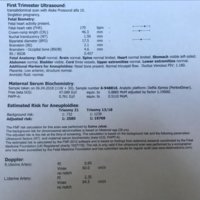I was seriously impressed after my scan I must say - they were really thorough and absolutely lovely. We are at Kings College London and the fetal medicine centre is pretty state of the art so I was happy about that having not been too impressed with the state of the midwife centre!
Lucy, my nt was 1.50mm. I was only 11+3 at the time so they werent sure if I was far along enough to do the test but they seemed happy with what they were able to get. I have nothing to compare this to this being my first pregnancy so I just assumed all was okay but Im panicking a little that my numbers are lower than they should be for a 28 year old. Do you know if they factor in the fathers age at all? My partner is 37 but not sure that really has much to do with it?
NCT says:
eening test.
The combined Down's syndrome screening test
The nationally recommended Downs syndrome screening process is the combined screening test which measures the nuchal translucency (see below) and two pregnancy hormones called Papp-A and HcG. This information is combined with the mothers age and the gestation of the baby to give a result. It is performed between 11 and 13 weeks of pregnancy.
Depending on the screening test you are offered, a combination of the following tests for Downs syndrome will be used along with your age and the gestation of the baby to calculate your result.
The*nuchal translucency scan*is an ultrasound scan which measures the pocket of fluid at the back of the babys neck. An increased amount of fluid may mean the baby has an increased chance of having Downs syndrome. The measurement is combined with a blood test and your age to estimate your risk.
The level of*a number of different*hormones*may be measured in the blood test part of Downs Syndrome screening.
will be given your Downs syndrome screening result as a statistical chance, e.g. 1 in 1000. In most hospitals, if your result is higher than 1 in 150 this will often be reported to you using the terms screen positive or high risk and you will be offered a diagnostic test such as CVS or amniocentesis.
If your result is a lower chance than 1 in 150, it will most often be reported as low risk and no further testing will be offered. This 1 in 150 figure is sometimes referred to as the cut off number.
However, a risk of 1 in 100 is very different from a risk of 1 in 4, although both results are described as screen positive or high risk. A 1 in 100 result means that you have a 1% risk of your baby having Downs syndrome and a 99% chance that your baby will not have the condition. But with a risk of 1 in 4 you would have a 25% chance of your baby having Downs.*
Hope this helps a bit x


